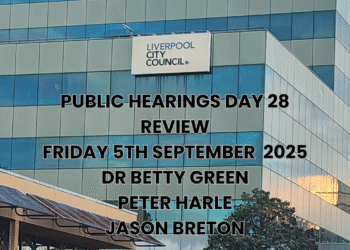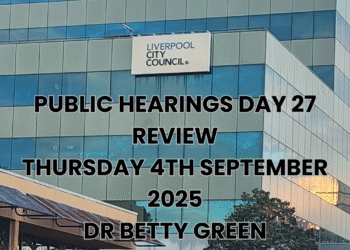On Monday, 28 July 2025, the public inquiry into Liverpool City Council progressed to its tenth day of hearings in Sydney, conducted under Section 438U of the Local Government Act 1993 (NSW). For us in Liverpool, a vibrant community of over 250,000 residents spanning 305 square kilometres, this inquiry continues to expose critical details about the management of our council and the allocation of our rates. Tune in to 89.3 from 9am Thursdays with Michael and BJ on The Pulse for more community insights and discussion.
Dr Jackson’s testimony on Day 10 focused heavily on the Civic Place Project, a significant development initiative by Liverpool City Council, addressing its scope, financial risks, and the challenges he faced during his tenure as CEO.
Dr Jackson, who started at Liverpool City Council in late 2014 as Manager of Community Development and Planning, clarified that he had no direct managerial input into the Civic Place Project at that time. By late February 2016, when he became Acting Director of Community and Culture, the council was already considering the project in its initial narrower scope, costing approximately $75 million, under Acting CEO Michael Cullen (until May/June 2016) and later Kiersten Fishburn (from October 2016). The project was managed by John Morgan, Director of Property Services, not by Jackson in his roles during this period.
Dr Jackson confirmed that in late October 2018, under Kiersten Fishburn’s tenure as CEO, the council passed a resolution to significantly expand the scope of the Civic Place Project. This expansion involved a substantial increase in cost, the amount of borrowing required, and the physical scale of the project, including larger council facilities (e.g., the library increasing from 3,000 to 5,000 square meters) and expanded office and commercial leasing space. Notably, at the time of this decision, there was no binding agreement with potential tenants like the University of Wollongong to occupy the commercial space, despite informal indications of interest.
This expansion without secured tenants poses a major concern for us ratepayers. Deciding to increase the project’s scope—and thereby its cost and debt burden—without guaranteed occupants for commercial spaces represents a significant financial risk. If spaces remain unleased, the council (and by extension, our rates) could bear the cost of empty properties, diverting funds from essential services like road repairs or community programs.
Reports and criticisms mentioned by Ms Richardson (though Dr Jackson was unaware of specifics like the Centium report or a 2022 Auditor-General’s critique due to leaving the council in February 2022) suggest this risk was later recognized as a misstep.
Dr Jackson, who became Acting CEO in June 2020 and substantive CEO in November 2020, discussed inheriting the Civic Place Project as a significant issue during his leadership, particularly from December 2020 onward. He spent considerable time seeking external funding from commercial lenders after the Treasury Corporation (TCorp) refused to lend the necessary amount for the expanded scope. However, he disagreed with Ms Richardson’s assertion that the expansion directly caused the funding issues, arguing that the expansion was well-thought-out to meet community demands (for a civic plaza, library, childcare, etc.) and that the core challenge was securing loans within a tight timeframe, regardless of whether the project cost was $75 million or $200 million.
For Liverpool residents, the struggle to secure funding for Civic Place during Dr Jackson’s tenure as CEO is alarming. The need to seek commercial loans after TCorp’s refusal indicates potential overreach in the project’s ambition relative to available resources. As ratepayers, we face the risk of increased debt servicing costs or rate hikes to cover such loans, reducing the budget for other local priorities. The fact that a CEO had to dedicate significant time to funding solutions—amidst other pressures like COVID—suggests that earlier planning may have underestimated financial constraints, impacting our community’s fiscal health.
As ratepayers in Liverpool, the insights from Day 10 of the inquiry reveal troubling aspects of financial planning and risk management at our council. The Civic Place Project, expanded significantly in 2018 without binding tenant agreements, highlights a gamble with our money. Unleased commercial spaces or unmet funding goals could mean wasted resources, directly cutting into funds for community needs across our suburbs.
Even more concerning is the long-term impact of funding challenges faced during Dr Jackson’s time as CEO. The reliance on external loans after TCorp’s refusal signals potential debt burdens that we, as ratepayers, might shoulder through higher rates or reduced services. With a council budget over $530 million, every decision on a project of this scale affects us—whether it’s fewer park upgrades or delayed infrastructure projects. We need a council that balances ambition with fiscal caution to protect our contributions.



























